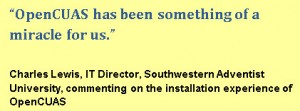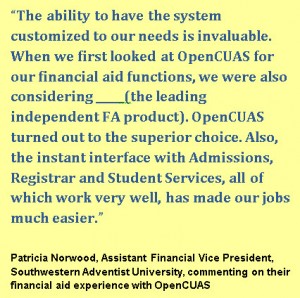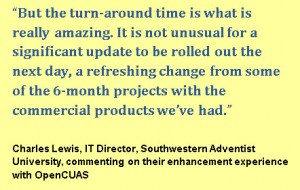The example used throughout this presentation is OpenCUAS (Open Community University Administrative System), an open source, academic administrative system for supporting the wide variety of functionality necessary to make a modern university function effectively. It is an excellent example for demonstrating the capabilities of AOA because it requires both great breadth and great depth of functionality and requires that functionality to work in both an MS Windows and a web environment. In addition, it has a number of b-to-b interfaces with state and local governments to exchange information in both directions, sometimes using file formats and other times using XML.
system for supporting the wide variety of functionality necessary to make a modern university function effectively. It is an excellent example for demonstrating the capabilities of AOA because it requires both great breadth and great depth of functionality and requires that functionality to work in both an MS Windows and a web environment. In addition, it has a number of b-to-b interfaces with state and local governments to exchange information in both directions, sometimes using file formats and other times using XML.
OpenCUAS is composed of 11 functional areas, each with significant depth of its own. In fact, there are several stand-alone products in the market that address only one, or a couple of those functional areas. The functional areas supported by OpenCUAS include:
- Admissions and Prospect Processing
- Student Academics
- Student Accounts
- Student Financial Aid
- Student Life
- Human Resources (though not including payroll)
- General Ledger
- Accounts Payable
- Budgeting
- Constituency (Alumni and Church Interaction)
- Development (Donor and Fund Processing)
OpenCUAS is important for demonstrating solutions to both the modification and portability problems and also for demonstrating an order of magnitude improvement in application development productivity.
The OpenCUAS system, including all 11 functional areas above, was designed and built from scratch with less than 15 man-years of effort. This effort included full installation at two sites, along with significant customization at the second site and the constant porting of modifications back and forth between the two sites over a two-year period.
To put this effort in perspective, it is very common for small to medium universities to have 8 to 10 people whose efforts are entirely directed at working with and supplementing the school’s proprietary ERP system. (The two OpenCUAS sites each have a single such person.) This means these schools typically spend more effort working with and around their ERP’s in a two-year time-frame than was spent on the entire OpenCUAS development and installation effort. In fact, there is a school in Boston that spends more effort in 9 months customizing their proprietary ERP than was spent on the entire OpenCUAS development and installation.
In weighing this effort, there is, of course, the question as to the quality and depth of OpenCUAS relative to the major proprietary systems in the market. Toward that end, it should be noted that OpenCUAS is at least competitive to those other products, particularly in the three most complex functional areas, Student Academics, Financial Aid and Student Accounts.
The experience of Southwestern Adventist University in Texas is of particular importance in evaluating OpenCUAS and the AOA foundation on which it was built, as they have had recent experience with two of the industry’s main proprietary products and they were the second OpenCUAS user, thereby experiencing the customization and enhancement capabilities of AOA. Charles Lewis, IT Director at Southwestern, expressed his experience in the following.
“OpenCUAS has been something of a miracle for us. Over the past 30 years I have been involved with 2 homegrown systems and 2 commercial systems and OpenCUAS is the shining light among them all. It just fits. It has been by far the easiest  system that I have implemented. For example, we had a working transcript in 2 weeks. The design and structure of the product reveals the handiwork of someone who understands the needs of small private institutions. And I have never before experienced the kind of enhancement process that takes place when we have a requirement that needs to be filled. The vendor has exhibited an unusually quick understanding of the problem, and the end result is always better than what we originally envisioned. But the turn-around time is what is really amazing. It is not unusual for a significant update to be rolled out the next day, a refreshing change from some of the 6-month projects with the commercial products we’ve had.”
system that I have implemented. For example, we had a working transcript in 2 weeks. The design and structure of the product reveals the handiwork of someone who understands the needs of small private institutions. And I have never before experienced the kind of enhancement process that takes place when we have a requirement that needs to be filled. The vendor has exhibited an unusually quick understanding of the problem, and the end result is always better than what we originally envisioned. But the turn-around time is what is really amazing. It is not unusual for a significant update to be rolled out the next day, a refreshing change from some of the 6-month projects with the commercial products we’ve had.”